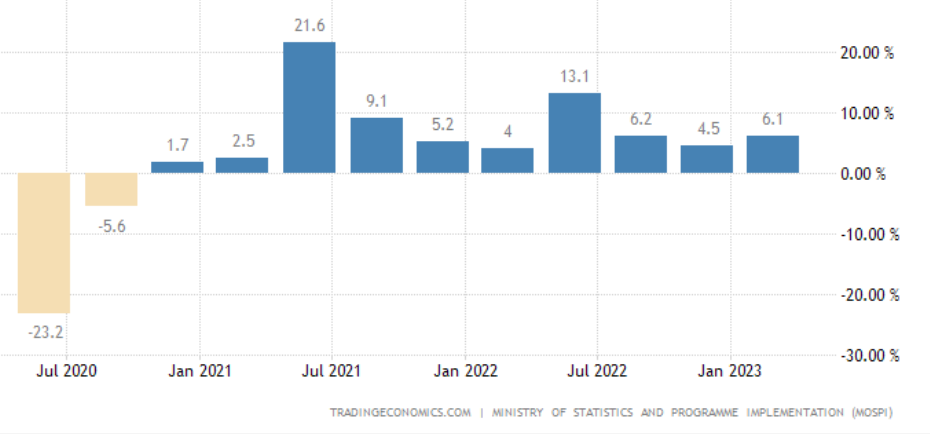
India recorded a higher-than-expected GDP growth rate of 6.1% in January-March 2023, according to the latest data from the National Statistical Office. This has raised hopes for the full-year growth estimate of 7.2% for 2022-23, surpassing the NSO’s advance estimate of 7%. India’s growth is particularly noteworthy considering the global economic downturn, although Japan, the United States, and China have all shown faster growth in the latest quarter.
The faster GDP growth can be attributed to a revival in the services sector following the pandemic as people resumed activities like dining out, shopping at malls, and staying in hotels. Additionally, growth was propelled by the transportation sector and increased investment. However, private final consumption expenditure experienced muted growth.
READ I RBI seeks to fortify banks against hidden stress, governance gaps
Graphic: India annual GDP growth rate

Despite being a standout performer in challenging global conditions, India’s GDP growth in FY2022-23 is lower than the 9.1% growth rate recorded in 2021-22. Furthermore, there is a need to guard against over-enthusiasm as the impressive results this quarter are partly due to a lower base effect from the previous year.
The economy faced a significant contraction in FY21 due to pandemic-related lockdowns and disruptions. While there has been a recovery, there may still be lingering effects. Additionally, the Indian economy faces several challenges, including subdued exports and trade which can impede growth due to global spillovers.
There are also some inconsistencies in the data. For example, agricultural growth stood at 5.5% for Q4, reaching an 11-quarter high, despite the expected impact of heat waves on cultivation during the rabi season. Moreover, rural consumption is closely linked to agriculture, and the recovery in rural demand does not align with the stellar growth in agriculture. If agriculture had truly experienced significant growth, it should have been reflected in rural demand as well.
Looking ahead, the coming year presents a multitude of risks that policymakers and the government must identify and address as a key priority. Some of these risks include stagnant consumption growth, uneven development, inflation, slower rural demand, and correcting the lower base effect.
Regarding consumption growth, last year’s output was primarily driven by consumption, but it is now showing signs of decline. Tight monetary policies, inflation, and the risks associated with an uneven monsoon are likely to further impact consumption recovery. Additionally, there are indications of slowing hiring intentions in certain sectors like Information Technology (IT). All of these factors could contribute to lower consumption growth in the future. To counteract this downward trend in pent-up demand, private sector investment must increase this year.
Moreover, exports are expected to remain subdued due to geopolitical circumstances. The ongoing disagreement between Ukraine and Russia has weighed down global growth prospects. Consequently, India’s export sector is likely to continue suffering, resulting in exports not contributing to growth this year. Analysts believe that maintaining growth at 6% or higher will be challenging in the face of a global slowdown. Close monitoring of monsoon prospects is also necessary as they have a significant impact on rural demand.
GDP vs social welfare
While GDP numbers are often celebrated, they provide limited insight into changes in the welfare of the population. In fact, GDP growth is not necessarily indicative of how the benefits of that growth are distributed. The Reserve Bank of India projected real GDP growth of 7% for 2022-23 and 6.5% for 2023-24. Although India is one of the world’s fastest-growing economies, the growth is inequitable and primarily benefits a small section of society.
A large portion of the Indian population still faces financial struggles, as evidenced by the persistent challenges in the agriculture sector over the past few years. Insufficient job opportunities for India’s youth are reflected in the low labour force participation rate.
GDP numbers at a glance
The GDP numbers surpassed expectations, with the economy growing at 6.1% in the fourth quarter of the previous fiscal year, up from 4.5% in the third quarter. However, in nominal terms, the economy experienced slower growth in the fourth quarter.
Agricultural growth in Q4 was estimated at 5.5%, compared to 4.1% in the same period the previous year and 4.7% in the previous quarter. On the other hand, manufacturing growth rebounded to a year-on-year growth of 4.5% in Q4 after contracting in the last two quarters. Analysts attribute this pickup to improvements in both volumes and margins.
The construction sector, another labour-intensive industry, has also performed well, with estimated growth of 10% for the full year. The financial, real estate, and professional services sector has also experienced sustained growth over the year.
However, the performance of the private consumption sector has remained dismal, with only 2.8% growth in the fourth quarter, slightly higher than the 2.2% growth in the third quarter. This can be partly attributed to the subdued performance of the consumer durables segment in the index of industrial production. Concerns about the monsoon and its impact on rural demand are also prevalent.
